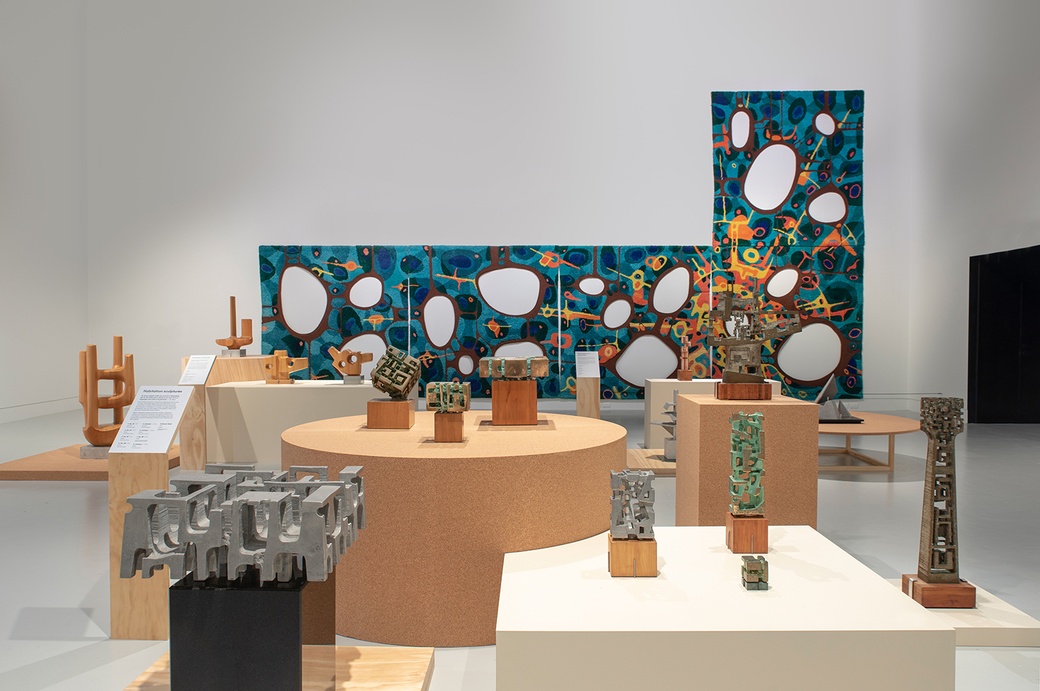

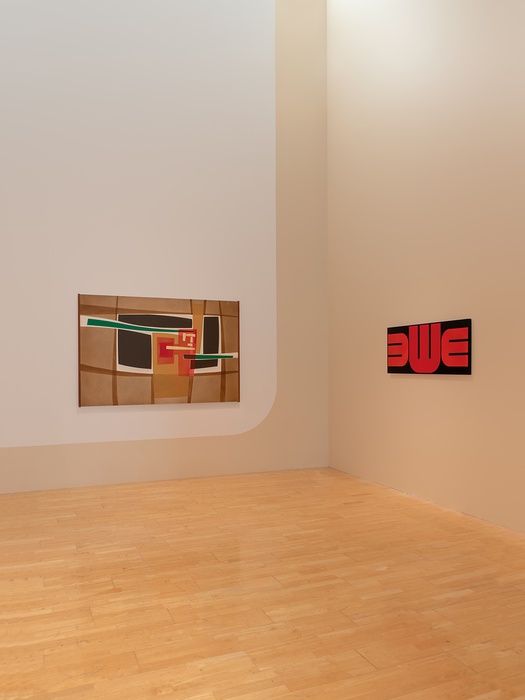
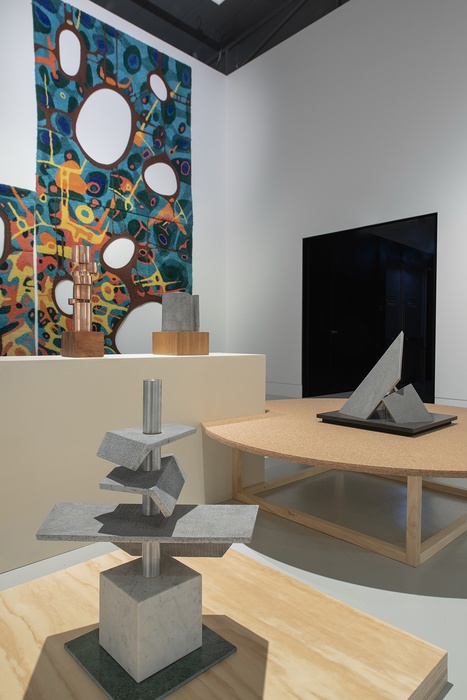

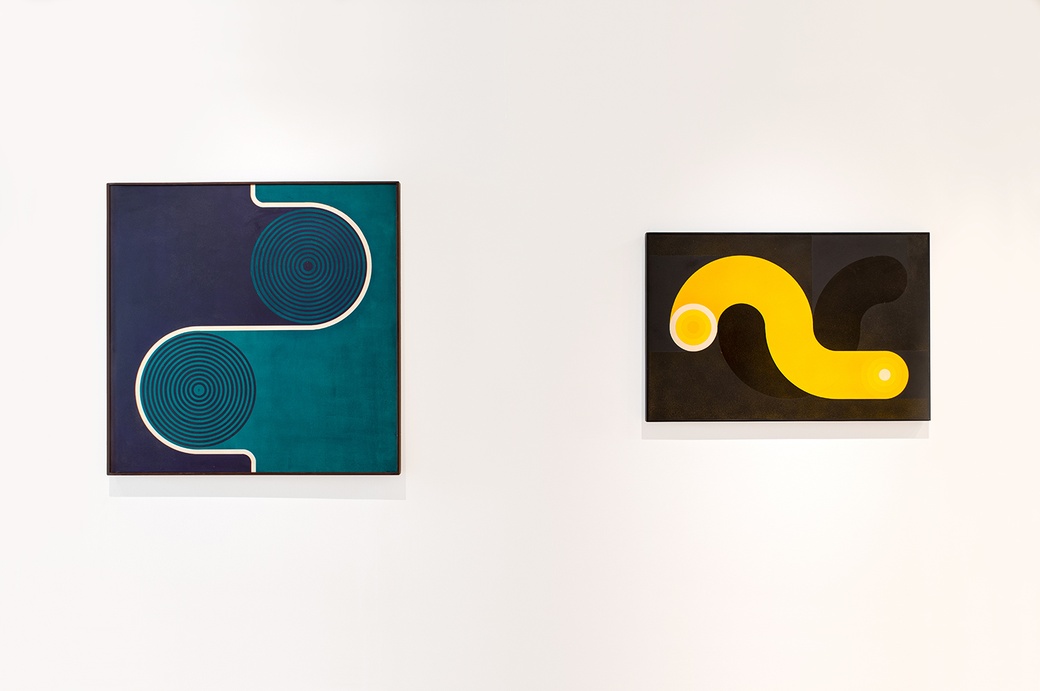
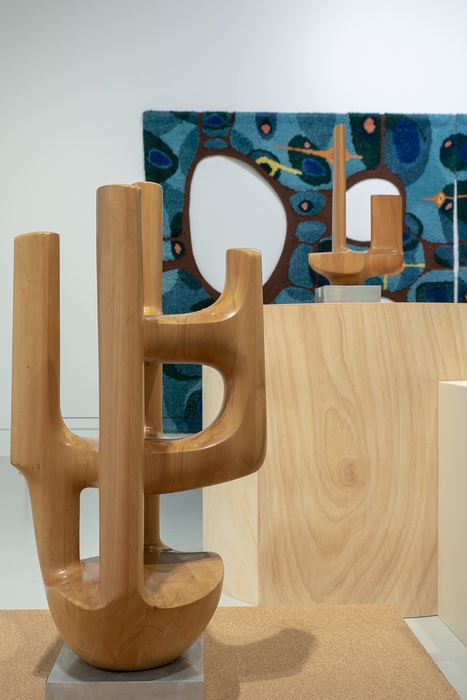
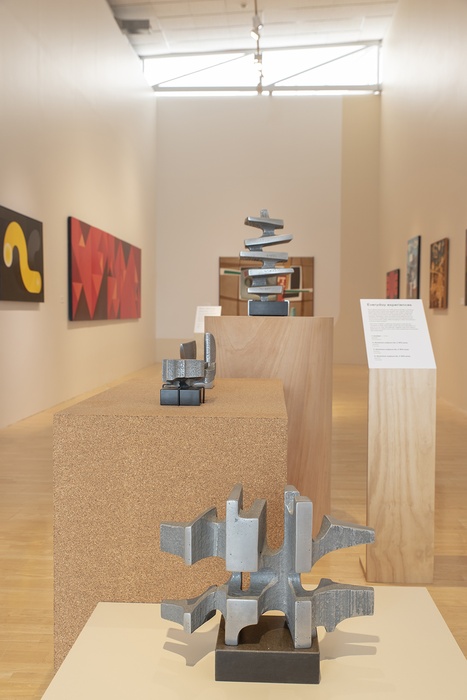
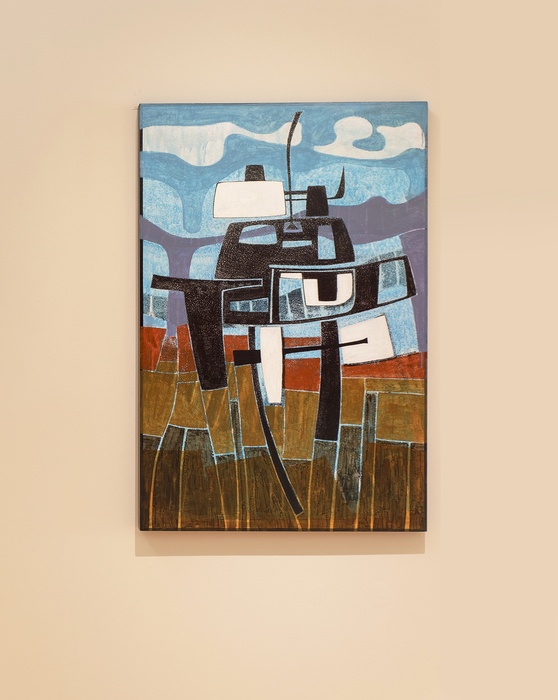
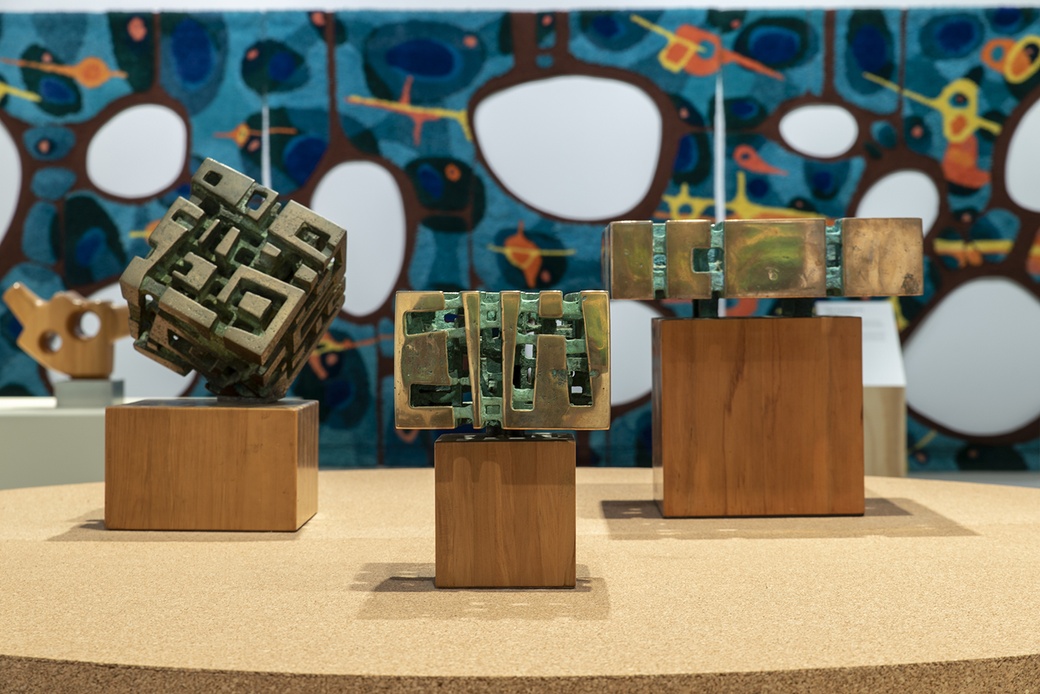
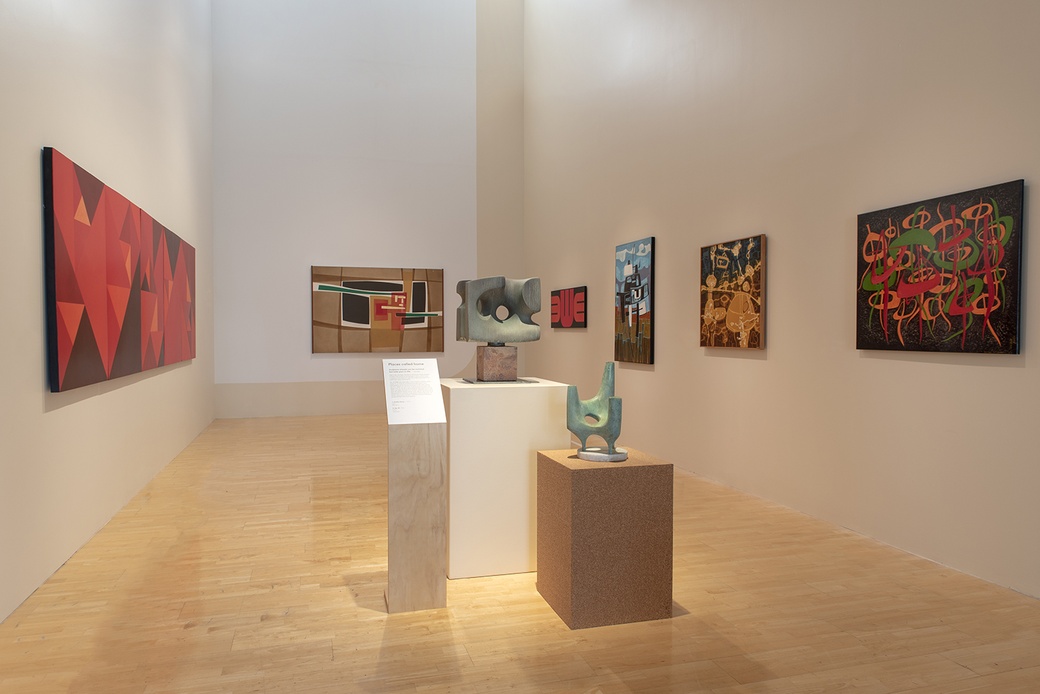
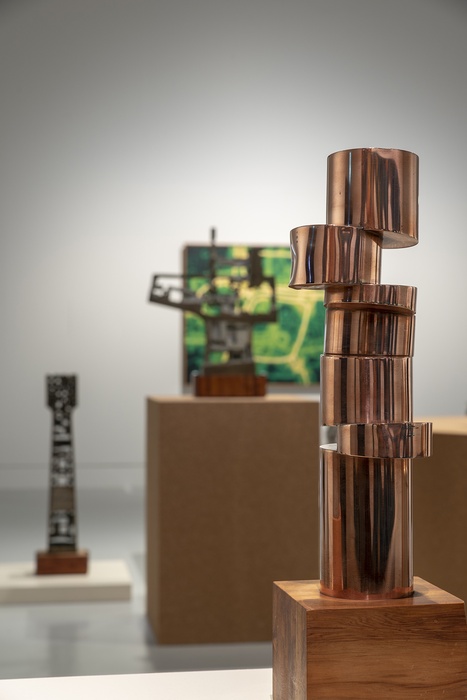
Guy Ngan: Habitation. Installation view. Photo: John Lake
“Sculpture is not a static thing, it should not be isolated, but take part in life.”
– Guy Ngan
Guy Ngan 顏國 鍇 (1926 – 2017) was a prolific artist based in Stokes Valley, Lower Hutt who was passionate about making art that could connect us more with our surroundings and each other.
Guy Ngan: Habitation considers how notions of place and belonging influenced his expansive practice, which was grounded in his Chinese heritage, his home in Te Moana nui a Kiwa (the Pacific), and his studies across Aotearoa New Zealand, the United Kingdom and Italy.
The artist’s impressions of his childhood in Guangzhou, China, can be seen in his brightly coloured screen prints infused with the gestural brush work of guohua (classical Chinese painting). Similarly, his painting Celebration (2008) from his Middle Kingdom 中國 series uses Chinese characters to reflect his pride in China.
Living as an adult in Aotearoa New Zealand, Ngan formed an affinity with the local landscape, particularly coastal rock formations and native bush, which were frequent destinations of family trips. In this exhibition, you can see the influence of native bush in the lush green painting Waoku No. 2 (1973) that responds to Mount Taranaki and its surrounding area, and panels from the large-scale public mural Forest in the Sun (1976), a collaborative textile he created with Joan Calvert for the Beehive.
Ngan was well known for making public sculptures and murals nationwide. He believed that “buildings should reflect our feelings” and one of his biggest inspirations was modernist architecture, which developed during his time in London in the 1950s. A discipline that continues to impact us today, modernist architecture can be reduced to a simple idea—making uncomplicated spaces that respond to people’s habits and needs. Both Ngan’s two and three dimensional works are like visual translations of such spaces, particularly his Habitation sculptures. Ngan has made over 200 of these, each one carved from polystyrene with hot wire to create contrasting angles and curves before being cast in aluminium or bronze. With the appearance of miniature buildings, they are inspired by Roman ruins, Chinese calligraphy and shapes carved out of rocks by the ocean.
In response to Ngan’s influences, Kingsley Baird, a professor at Massey University, former apprentice and friend of the artist reflects:
“Guy was intensely interested in humanity, including the migrations of peoples across the globe throughout history and, primarily, what links them, culturally and genetically. I believe his Habitation series is an example of his interest in places occupied by people.”
Bringing these components together, Guy Ngan: Habitation shows the artist’s unique approach as a Pacific Chinese person, and what his perspective can tell us about Aotearoa New Zealand’s increasing diversity.
BIOGRAPHY
Guy Ngan (1926 – 2017) was a second generation Chinese-New Zealander born in Wellington. In 1928, his parents, frustrated by the way they were often treated, moved with their two sons from Newtown, Wellington to Guangzhou, China. As the ninth child of fifteen in a family of three wives, Ngan and his brother lived in one of his father’s three homes, where his interest in the arts was encouraged with books and painting materials, while he received a traditional Chinese education. With the outbreak of the Sino-Japanese War in 1937, in 1938 Ngan’s parents sent their two sons back to New Zealand.
From the age of fourteen, Ngan supported himself through woodcarving and furniture-making, learning from Hori Young and cabinet maker Billy Gee. At 17, he began night school at Wellington Technical College with sculptor Alex Fraser. Under the advice of Fraser, Ngan travelled to London in 1951 to continue his education at Goldsmiths College while working for well-known sculpture John Skeaping. He went on to attend the Royal College of Art, graduating in 1954 as a Designer of the School of Wood, Metal and Plastics and then, under a scholarship, spent three months at the British School in Rome. After working in the UK and travelling to Scandinavia and North America, Ngan returned to New Zealand, having been enticed back by Gordon Wilson, the Government Architect. Here he was employed in the Ministry of Works Architectural Division, where he spent four years, followed by ten years as an Associate Partner for Australian based architects Stephenson & Turner.
Over his time working in architecture, Ngan continued to develop his artistic practice, and in 1970, he became a full time artist and designer, launching solo exhibitions at galleries including The Dowse (1972), Antipodes Gallery, Wellington (1974), New Vision Gallery, Auckland (1976), The Hastings Cultural Centre (1979) and The Southland Museum and Art Gallery (1979). Ngan built and designed his family home between 1950s and 80s, and from 1944 to 2012, created over forty public woodcarvings, sculptures and murals across New Zealand, with work also commissioned for the Asian Development Bank, Manila, Air New Zealand Tahiti and the United Nations Building, New York. He exhibited frequently at The New Zealand Academy of Fine Arts, Wellington, where he had been a member since the 1940s, and also Director from 1976-’86, championing the creative endeavours of his fellow artists. In 1983, he received an OBE for services to the arts and in 2006, he had a solo exhibition entitled Guy Ngan: Journey: Aluminium Panel, Tiki Hands, and Anchor Stones at City Gallery Wellington. In 2012, at age 86, Ngan was inducted into The Massey University College of Creative Arts Hall of Fame.
IN THE MEDIA
A lost 65-year-old mural brought back to life in Naenae, Hutt City Council, 01 May, 2024
Artist Guy Ngan's Stokes Valley home is an artwork in its own right, Stuff.co.nz, Nov 27 2018. Matthew Tso
The public and private art of Guy Ngan, Mark Amery, Standing Room Only, 2 June 2019
Exhibitions honour well-known modernist Guy Ngan, Courtney Johnston, Nine To Noon, 12 June 2019
Immigrant Songs, Hamish Coney, newsroom, 12 July 2019
Guy Ngan at Artspace, John Hurrell, 12 July 2019
Guy Ngan: Either Possible or Necessary, exhibition at Artspace Aotearoa, 7 June – 17 August 2019